 |
The Guérite |
 |
|
|
|
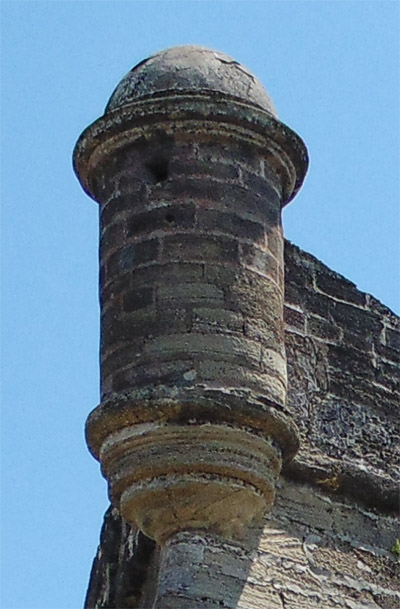
|
 |
Not a dingleberry
The Guérite is a wall-mounted, overhanging masonry turret that was selectively employed on starforts of the Spanish, Portuguese, Dutch and, to a lesser extent, French and English persuasion. Known as a garita in Spanish, this entity hails from medieval fortifications: European Castles built from the 14th to 16th centuries often had Bartizans, which were essentially the same as guérites.
In practice, a guérite is a protected one-man observation post, sometimes referred to as a sentry box, placed at the tip of a starfort's bastion, from whence a sentry could keep an eye on the fort's approaches without being exposed to fire. What that sentry could see was usually fairly limited, as the hole through which he would peer was small, generally only a few inches, in a square- or rectangle-shaped opening.
In cases where a guérite was not built onto all corners of a seaside starfort, they would generally only face the landward side: This makes sense, in that an enemy approaching from the land would notionally prove more of an immediate threat to a sentry, at least in the 16th or 17th century. |
 |
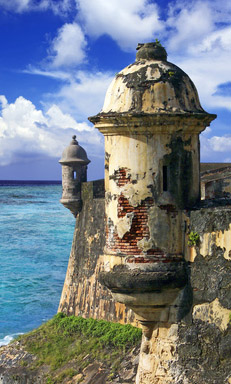
Two of San Felipe del Morro's garitas |
|
|
A ships' guns of that era would be lucky indeed to hit such a small target as a guérite at a distance, without a great deal of lengthy, concentrated fire. Hopefully a sentry would have the wit to relocate prior to immolation. |
|
As guérites were holdovers from the days when castles were the state of the art of fortification, it's interesting to note who held onto this, what today seems like no more than an affectation: Spain and Portugal, the two main offenders in this case, were known to embrace needless decoration in their military engineering a great deal more than the other European powers at the time. Great Britain built what they called observation turrets on some of their earlier starforts, many of which were really just upgrades of earlier castles, which may explain why the bartizan concept was retained. France built very few; but one of these was on the Father of the Starfort's namesake fortification, the Citadelle Vauban - so one assumes he thought it was a reasonable concept. And it's hard to argue starforts with Vauban. The French design differs from the others' in that it is more angular, with a series of flat surfaces as opposed to being uniformly cylindrical. But let's face it: The whole idea of a starfort is that its clean lines and unlimited visibility were designed to give its notional attackers nothing to reasonably attack; no hope of approaching its walls unseen. Put some bulky, bulbous protrusion on your starfort corner, and you've got both a target and a potential dead zone for observation, even if a tiny one: I mean, duh!
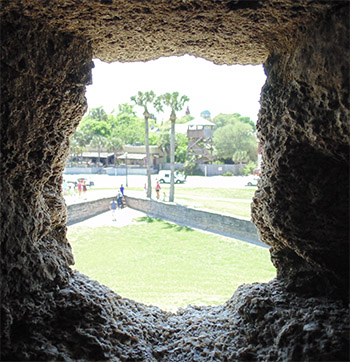
What can you see from inside a garita? Here's what you can see: Muy poco. |
 |
The first guérite I came across in my starfort studies was that on Fort Orange, a Dutch fort in Brazil. And I was aghast. Indignant. Furious. How could anyone, given the awesome task of building a starfort to defend the colonial realm, be so irresponsible?! I initially thought that this blight on the holy, pristine starfort corner was an aberration. But I simply hadn't been paying attention. Because the guérite occurs far more frequently than I had appreciated. I was completely ready to blame the over-ornamentational nature of Catholicism for the unnecessary guérite, until I found that Spain and Portugal weren't the only empires employing them. |
It is certainly true that the Spanish in particular were given to a great deal of needless decoration of their military wares: Forts, ships, cannon and just about anything else that could be swirlingly decorated, was, for the greater glory of God (but moreso for the greater glory of the Kings Philip). But use of the guérite seems to have more to do with castles: Those nations that built castles, stuck with the guérite when they began upgrading their defenses to the starfort. The one nation that built a whole lot of starforts but not a single guérite? The United States of America. I'd like to think this was due to the American understanding of the true nature of the starfort, but I suspect it was mostly because there were no castles in the New World. When the US was a young nation in need of fortification in the late 18th and early 19th centuries, but had no military engineers of its own, it employed European fortification experts: French engineers Simon Bernard (1779-1839) and Pierre Charles L'Enfant (1754-1825) were two of the most conspicuous. Some Dutch engineers were employed as well, but as the US was at odds with Spain at the time, thankfully no "experts" who would have insisted on guérites designed the starforts of the United States. The Spanish of course did build starforts with guérites in what would become the United States, the most famous being the Castillo de San Marcos, built at St. Augustine, Florida, from 1672-1696. I visited the Castillo in April of 2014, and had my first experience with a guérite. |
 |
|
|
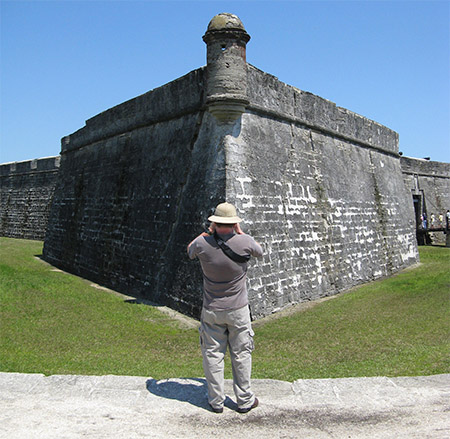 Me coming to terms with the guérite Me coming to terms with the guérite |
 |
The Castillo de San Marcos is an impressive chunk of 17th century colonial power in a land of comparatively dainty-looking 19th century scientific fortification. It's been St. Augustine's main tourist attraction ever since the US obtained Florida from Spain in 1819. The Castillo was officially handed over to the US government on July 10, 1821, and its new owners somehow resisted the urge to "modernize" their new fort. The Castillo has undergone some changes, but today looks as much like it did in its Spanish days as is possible.
Except for its color! It its glory days, the Castillo was plastered white, and its guérites bright red: This was to mimic the colors of the flag of the Cross of Burgundy, which was the Spanish flag from 1505 to 1785. As it says on a marker at the Castillo, this was to serve as "a symbol of Spanish power and claim over La Florida."
The Castillo has a garite at the tip of all four of its bastions: The northwest corner has the Vigía de San Carlos, or Saint Charles Watchtower. This faces the Matanzas River, which leads to the Atlantic ocean, and is thus the direction from whence trouble would most likely come.
|
|
When I first arrived at the Castillo, I was thoroughly convinced that guérites were stupid, ill-conceived fripperies. Once I was able to step inside and study one, however, my opinion immediately changed. Much like the rest of the Castillo, to call its garitas overengineered would be an understatement: They're stout little fortlets in and of themselves.
|
|
|
|
But it's pretty difficult not to feel relatively cozy and secure in a garita. And there's plenty of bastion wall space o'er which one can peer, should one need a better view than is available through a garita's observation hole. Perhaps, I concluded, there actually is something to the guérite concept after all.
|
 |
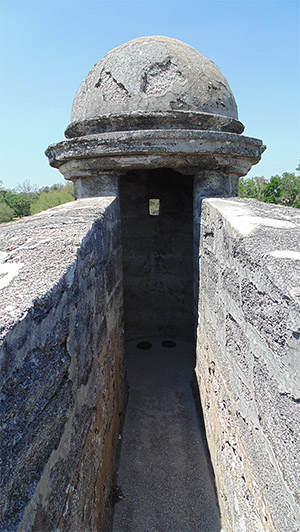 The Castillo de San Marcos' southeastern garita The Castillo de San Marcos' southeastern garita |
|
|


